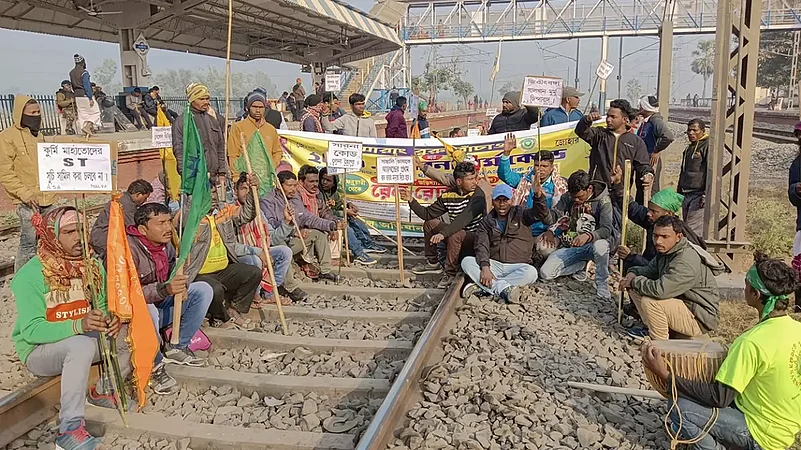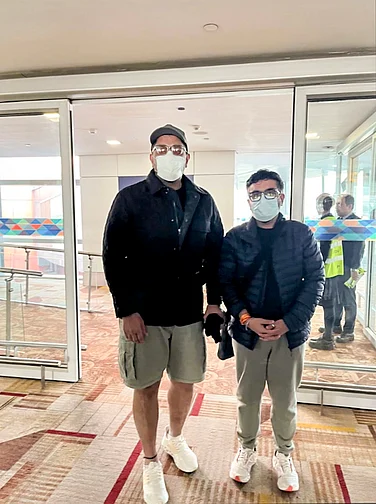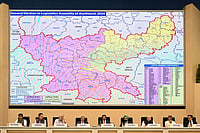In the first week of April, a five-day protest by the Kudmi-Mahato community in Jharkhand’s districts bordering Odisha and Bengal caused material damages worth crores. According to a report, a 60-km long highway stretched was blocked by the protesters. Meanwhile, Railways officials said that 435 trains had to be cancelled, causing losses worth more than 1,700 crores.
This was the second massive stir by the community within six months after they stopped trains and blocked a highway for similar demands in September. There is no guarantee that the protests would not break out again. An influential community leader has warned that if their demands are not met by September this year, they would protest again. On the other hand, the Adivasis have also taken to the roads opposing the demands of the Kudmis.
Why are the Kudmis protesting repeatedly? What are their demands? Before breaching the subject, it is pertinent to take a look at the recent developments in Manipur. The state has a population of around 35 lakhs, with Meitei, Naga and Kuki being the three largest communities. Mostly Hindu Meities are the largest community by population, while the Nagas and Kukis are classified as Scheduled Tribes and largely follow Christianity. Meiteis dominate political representation with a population share of around 70 per cent. This community has been demanding an ST status, insisting that they had been classified as tribals before 1949 when Manipur was merged into the Union of India. However, the Naga and Kuki tribes have opposed the Meteis’ demands, arguing that the latter community does not qualify as an ST and they already enjoy reservations under the OBC and SC categories. If the Meiteis are granted the ST status, this would reduce jobs and higher opportunities for the other tribes of the state, the opponents of their demand claim.
A rift between the Kudmi-Mahatos and the Adivasis has developed along the same lines. The Kudmis have been demanding their inclusion in the STs for a long time. They claim that they were included in the category until 1950. As per the community, their largest populations live in Jharkhand, Bengal and Odisha, numbering 72, 30 and 25 lakh people respectively. Currently, they are classified as an Other Backward Caste. The community has written to the prime minister demanding ST status under Article 342 of the constitution.
The origins of the Kudmis’ demand
IIT Bombay researcher Kunal Shahdeo says that “Until the 1921 census, the Kudmi Mahato community was recognized as animists and tribals. However, they were removed from this category in 1931. No census was carried out in 1941 due to World War II. In 1950, when the constitution came into effect, they were not included in the STs. Later, they were included in the OBCs on this basis.”
Shahdeo adds that anthropologists such as Kumar Suresh Singh hold that the Kudmo-Mahatos were originally farmers and form a socially economically powerful community. They considered themselves Kshatriyas (warriors) for a long time. The Akhil Bharatiya Kudmi Kshatriya Mahasabha was established in 1894 and remained active until 1930. The community also linked itself with Maratha King Shivaji. This resulted in rapid Hinduization, and their tribal identity disappeared. Thus, by 1931, they had turned into another (Hindu) caste.
The researcher cites Kumar Suresh Singh’s paper ‘The Mahato-Kurmi Mahasabha movement in Chhota Nagpur’ to say: “In 1969, the Shivaji Samaj was formed under the leadership of Vinod Bihari Mahato. In 1973, it merges with other groups to form the party Jharkhand Mukti Morcha, and joins the Jharkhand movement for separate statehood. Parallelly, the Kudmis also start raising the demand for ST status in the mid-1970s.”
Jharkhand can turn into another Manipur: Salkhan Murmu
The Kudmi-Mahatos have intensified their agitation after in September 2022, the central government decided to include many Scheduled Castes from five states into the ST category. Former MP Shailendra Mahato – who represented the East Singhbhum constituency in 1989 - has played a key role in the movement. He told Outlook: “We are angry because in 2004, when Arjun Munda was the chief minister, he had agreed to our demand and recommended our inclusion into the STs to the central government. Now he is the tribal affairs minister in centre, but refuses to act on his own recommendation. If our demands are not met by September 2023, we will again launch a nationwide movement. Our demand dates back to 1972. The Patna High Court has issued three judgements in our favour in 1924, 1939 and 1963, all of which accept that the Kudmi-Mahatos are a tribe.”
Meanwhile, another former MP and leader of the Adivasi Sengel Abhiyan, Salkhan Murmu, has consistently opposed the Kudmis’ demand. He said that the Adivasi community had called for a Bengal bandh on May 22 in this regard and warned: “It is do or die out here. Jharkhand can turn into another Manipur because if Kudmi-Mahatos are granted ST status, this would prove to be a death blow to the real STs. They (Kudmis) will dominate all the elections, jobs and education once they are classified as STS. They would even grab our lands. In future, even the Kudmis from Bihar and Uttar Pradesh could arrive here and benefit from the ST status.”
He adds: “They have filed a writ in the High Court against the interests of the STs. Similarly, AJSU Party (All Jharkhand Students Union) MP Chandra Prakash Chaudhary filed a case in the Supreme Court that OBC reservations should be ensured in Jharkhand’s local body elections. But at other times, they want to be included in the STs. They are agitating merely because they want to benefit from the reservations. If you carry out a survey in the villages, the entire Adivasi community is opposed to their demand.”
However, the Kudmi-Mahato community’s demand to be included in the STs has been endorsed by all three state governments in Jharkhand, Odisha and West Bengal.


























